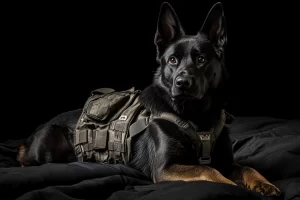Why a Purebred German Shepherd Might Be the Right Choice for a Home Protection Dog
Choosing the right breed for a home protection dog is a decision that understandably takes some care and thought. Among the many options available available, several reasons stand out for choosing a purebred German Shepherd puppy. This article explores five key reasons why a purebred German Shepherd puppy stands out as a superior choice for a home protection dog. Data supporting this claim will be by academic research and expert opinions.
Superior Intelligence
Let us be clear. By no means are we suggesting German Shepherds are the smartest of all breeds. Rather, the claim is that they function as a sort of Goldilock’s breed, a just the right kind of mix of the right kind of attributes for a home protection dog. Their high level of intelligence makes them highly trainable, an essential quality for a protection dog. According to Coren (1994), German Shepherds are capable of learning complex tasks quickly and can adapt to new situations with ease. This intelligence allows them to understand and execute commands effectively, which is crucial in high-pressure situations where quick and accurate responses are needed. Moreover, their problem-solving abilities enable them to handle unexpected scenarios, which is vital for ensuring the safety and security of their home environment. For instance, a well-trained German Shepherd can discern between a genuine threat and a harmless situation, reducing false alarms and enhancing the overall protection they provide. We’ll come back to what it means for the GSD to functions as. sort of Goldilocks’s breed as we continue considering other attributes.
Strong Protective Instincts
One of the primary reasons for selecting a German Shepherd as a protection dog is their strong protective instincts. Historically, German Shepherds were bred for herding and guarding livestock, which has ingrained in them a natural tendency to protect their family and territory. This breed’s loyalty and dedication to their owners make them vigilant and reliable guardians. Research by Svartberg (2005) indicates that German Shepherds score highly on measures of boldness and aggression when it comes to defending their home, making them excellent deterrents against potential intruders. Their protective nature is also evident in their behavior towards family members; they are known to be particularly gentle and watchful over children, making them an excellent choice for families. Additionally, their ability to sense and react to danger quickly makes them invaluable in emergency situations. Other breeds that could be considered could be Belgian Malinois. While excellent for special forces and in some cases even local law enforcement, the extreme high drive of this breed arguably makes the Malinois too high strung for most homes. The Rottweiler was bred for fighting and are not generally considered as easily trainable as working line purebred GSD. The purebred German Shepherd puppy is what can aptly be described as the “Goldilocks’ choice.” It is just right!
Physical Strength and Agility
The physical attributes of the German Shepherd make them well-suited for protection work. They are muscular dogs with a strong bite force, which can be a significant deterrent to intruders. Again, like Goldilocks, they can be described as just right. Arguably, they are not too big and not too small. As a medium sized dog, they are big and strong enough to get the job done, but no so big or aggressive as some breeds that they are a threat by merit of their sheer size or excessive drive. Additionally, their agility allows them to navigate various environments and respond swiftly to threats. A study by Helton (2009) highlights the breed’s exceptional physical capabilities, which include strength, speed, and endurance. These traits enable them to perform demanding protection tasks effectively, whether it involves chasing an intruder or guarding a perimeter. Their physical prowess also allows them to participate in activities that keep them fit and healthy, such as agility training, obedience trials, and other canine sports. This combination of strength and agility not only makes them formidable protectors but also ensures that they remain active and engaged during training. With the typical German Shepherd ranging from sixty to eighty pounds, depending on gender and bloodline, they are big enough to get handle protection work, but not so overwhelmingly large so as to give cause for concern. As you search for a purebred German Shepherd puppy for sale, look closely at parents and grandparents to see their size and temperament as an additional layer of getting the right fit for you and your home.
Versatile Training Applications
German Shepherds excel in a variety of training applications beyond just protection. Their versatility means they can be trained for obedience, search and rescue, and detection work, among other tasks. This adaptability ensures that a German Shepherd can fulfill multiple roles within a household, providing not only protection but also companionship and assistance. According to a study by Lefebvre, Diederich, and Giffroy (2007), German Shepherds are highly adaptable to different training methods and can perform a wide range of functions, making them valuable assets in any home. For example, they can be trained to assist individuals with disabilities, perform search and rescue operations in disaster-stricken areas, and detect substances such as drugs or explosives. This multifaceted ability makes them not only protectors but also invaluable partners in various capacities. The above studies are kind of a fancy way of saying these dogs are biddable, by this we mean trainable. The better the bloodline the more inclined the puppies will be in responsiveness to training. This is one of the most important reasons why choosing a purebred German puppy for sale over a rescue or a mixed mutt just makes sense. With a well bred dog, you can lean on genetics to know what to expect. For a home protection dog, finding that perfect purebred German puppy for sale only makes sense. Don’t gamble on the unknown.
Proven Track Record
The German Shepherd’s proven track record in law enforcement and military roles underscores their effectiveness as protection dogs. This breed has been utilized by police and military forces around the world due to their reliability, intelligence, and physical prowess. Their success in these demanding roles provides strong evidence of their capabilities in protecting homes and families. Research by Jones and Gosling (2005) supports the breed’s reputation for excellence in these areas, highlighting their consistent performance and reliability under pressure. German Shepherds have been instrumental in various high-stakes operations, such as detecting explosives in war zones, apprehending suspects in criminal activities, and locating missing persons. Their documented achievements in these fields speak volumes about their dependability and effectiveness, further solidifying their status as top-tier protection dogs. It is for this reason, that we at Czech working line only raise working line German Shepherds. We never raise show line dogs. For more about why this is, click here. With multiple generations of proven history, every purebred German Shepherd puppy for sale we offer comes from generation after generation of dogs with a proven track record. Over and over we are building on a foundation of dogs coming from health tested lines, checked for hips and elbows, tested for Degenerative Myelopathy (DM). Testing these dogs against Schutzhund standards, they are tested against an objective standard, not just a show ring that picks what we call a “do I look pretty kind of dog.”
Conclusion
In summary, at Czech Working Line, we believe the purebred German Shepherd’s intelligence, protective instincts, physical strength, versatility in training, and proven track record make them an excellent choice for a home protection dog. These traits ensure that they can effectively protect their family and home while also providing loyal companionship. For those seeking a reliable and capable protection dog, the German Shepherd is a breed worth considering. Their combination of mental acuity, physical prowess, and unwavering loyalty creates a unique profile that is difficult to match. When selecting a home protection dog, considering a purebred German Shepherd puppy may provide peace of mind and a steadfast guardian for years to come.
Bibliography
Coren, S. (1994). The Intelligence of Dogs. New York: Free Press.
Helton, W. S. (2009). Canine Ergonomics: The Science of Working Dogs. Boca Raton: CRC Press.
Jones, A. C., & Gosling, S. D. (2005). Temperament and Personality in Dogs (Canis familiaris): A Review and Evaluation of Past Research. Applied Animal Behaviour Science, 95(1-2), 1-53.
Lefebvre, D., Diederich, C., & Giffroy, J. M. (2007). Breed Differences in Domestic Dogs’ (Canis familiaris) Sensitivity to Human Communication: A Comparative Study of Belgian Shepherds, German Shepherds, and Labrador Retrievers. Journal of Comparative Psychology, 121(1), 27-31.
Svartberg, K. (2005). A Comparison of Behaviour in Test and in Everyday Life: Evidence of Three Consistent Boldness-Related Personality Traits in Dogs. Applied Animal Behaviour Science, 91(1-2), 103-128.
Additional Sources
Bennett, P. C., & Rohlf, V. I. (2007). Owner-Companion Dog Interactions: Relationships between Demographic Variables, Potentially Problematic Behaviors, Training Engagement, and Shared Activities. Applied Animal Behaviour Science, 102(1-2), 65-84.
Bradshaw, J. W. S., & McPherson, J. A. (2000). Dominance in Domestic Dogs – Useful Construct or Bad Habit? Journal of Veterinary Behavior, 4(5), 135-144.
Serpell, J. (1995). The Domestic Dog: Its Evolution, Behaviour, and Interactions with People. Cambridge: Cambridge University Press.
Smith, B. P., & Litchfield, C. A. (2010). How Well Do Dingo-Handlers Assess the Temperament of Animals? A Comparison of Ratings Made by Staff and Volunteers. Behavioural Processes, 84(1), 99-105.
Takeuchi, Y., & Mori, Y. (2006). Behavioral Profiles of Feral and Companion Dogs Assessed by Means of an Owner-Reported Questionnaire. Journal of Veterinary Behavior, 1(2), 79-84.
Udell, M. A. R., & Wynne, C. D. L. (2008). A Review of Domestic Dogs’ (Canis familiaris) Human-Like Behaviors: Or Why Behavior Analysts Should Stop Worrying and Love Their Dogs. Journal of the Experimental Analysis of Behavior, 89(2), 247-261.
Voith, V. L., & Borchelt, P. L. (1982). Dog Behavior Problems: An Overview. Animal Behaviour, 30(2), 101-110.




